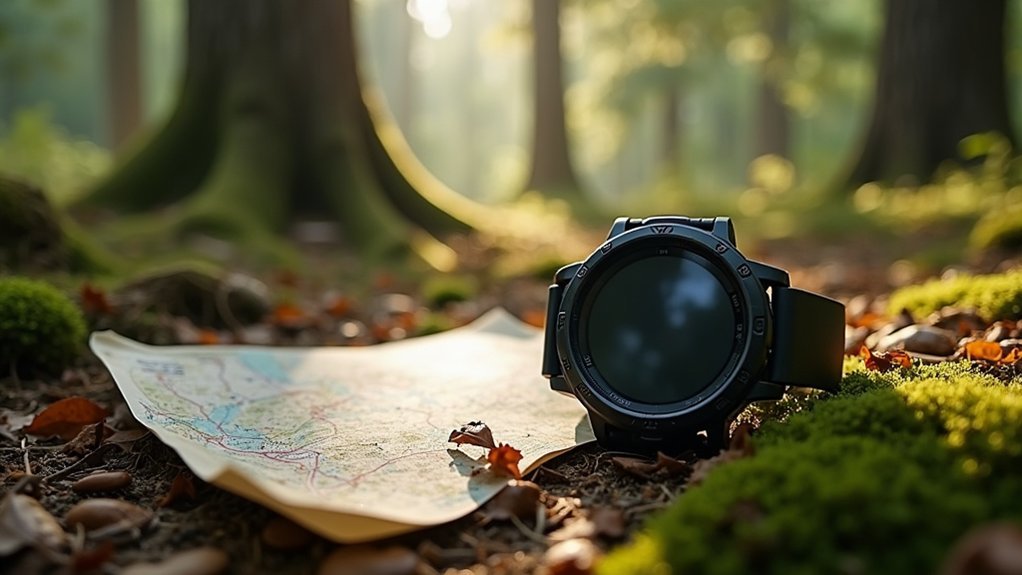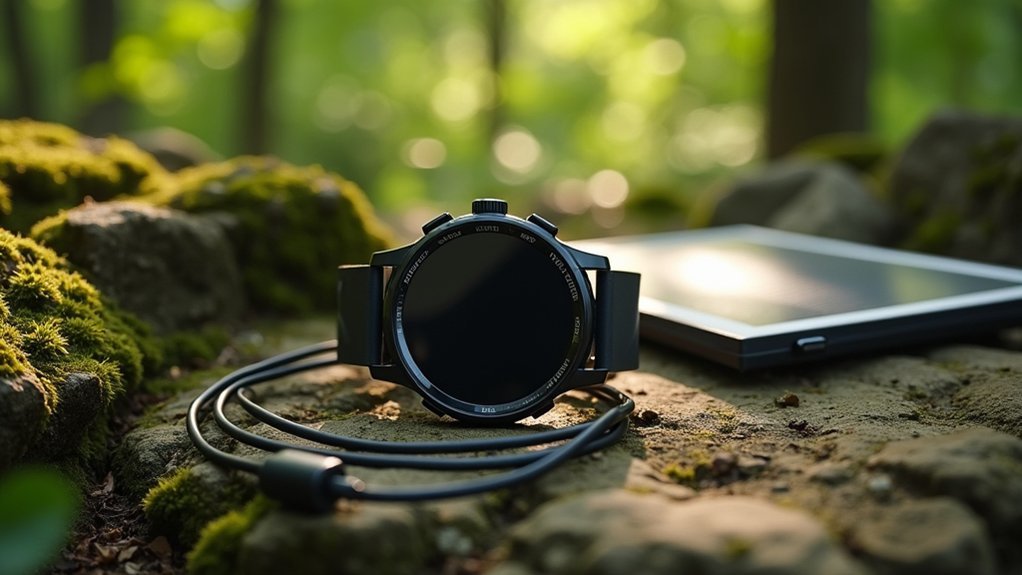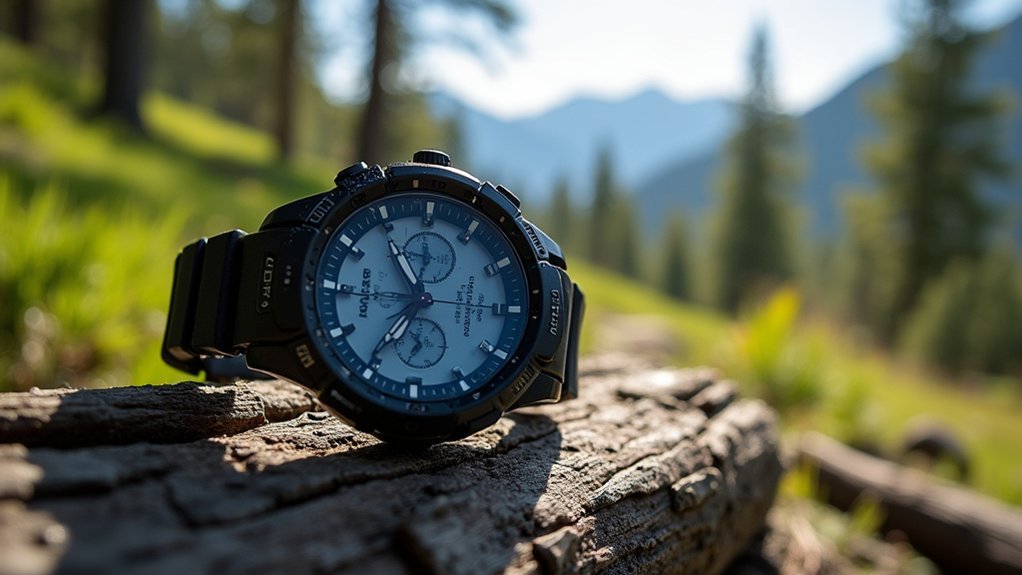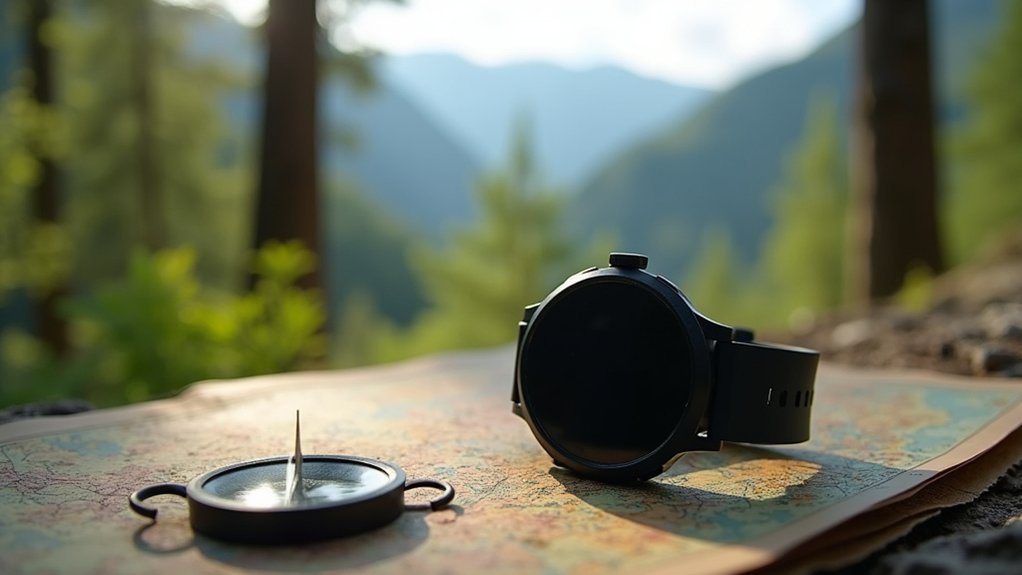For long-distance backpacking, you’ll want a GPS watch with exceptional battery life and reliable navigation features. Top options include the Garmin Enduro 3 with 120+ hours of GPS time, the Coros Vertix 2S offering 150+ hours, and the budget-friendly Coros Pace 3. Look for ABC sensors (altimeter, barometer, compass), water resistance, and solar charging capabilities for extended trips. The right watch balances battery performance with essential navigation tools for your wilderness adventures.
Why Battery Life Matters for Multi-Day Hiking Adventures

When you’re miles from civilization with nothing but wilderness surrounding you, your GPS watch becomes more than just a convenience—it’s a vital navigation tool and potential lifeline. Its battery life directly impacts your safety and route planning capabilities on long treks.
A dying watch can leave you without essential navigation data, elevation monitoring, and weather updates that help you make important decisions on the trail. While most watches can last months in basic timekeeping mode, activating GPS dramatically reduces this—sometimes to just 60 hours or less.
You’ll need to balance functionality against power consumption, especially on multi-week adventures where charging options are limited. Models like the Garmin Enduro 3 with its 120 hours of GPS functionality and solar charging capabilities make it ideal for extended backcountry expeditions.
Solar-charging models offer extended use, but you’ll still need strategies to preserve power during cloudy days or dense forest sections.
Top GPS Watch Models for Thru-Hikers and Backpackers
Choosing the right GPS watch can make or break your long-distance hiking experience. After extensive testing, three brands stand out for their reliability in the backcountry: Garmin, Coros, and Suunto.
| Brand | Top Model | Price Range | Best Feature |
|---|---|---|---|
| Garmin | Enduro 3 | $800-900 | Superior navigation |
| Coros | Vertix 2S | $500-700 | Exceptional battery life |
| Suunto | Vertical Titanium Solar | $700-800 | Durability in harsh conditions |
| Budget Pick | Coros Pace 3 | $350 | Lightweight (53g) |
When selecting your watch, prioritize models with ABC sensors (altimeter, barometer, compass) and offline navigation capabilities. Most recommended watches offer at least 100 meters of water resistance to handle river crossings and unexpected downpours. Premium options offer advanced mapping, but you’ll pay more. For thru-hikers, solar charging models like Garmin’s Instinct 2 Solar provide extended power without frequent recharging.
Comparing Battery Performance: Solar vs. Standard Charging

Battery life remains the most critical factor for GPS watches on long backpacking adventures, especially where charging opportunities are scarce.
Battery life stands as the ultimate deciding factor when choosing a GPS watch for remote wilderness expeditions.
The Garmin Instinct 2 Solar offers remarkable longevity with up to 28 days in smartwatch mode and potentially unlimited battery with adequate sun exposure (3 hours daily in 50,000 lux conditions).
By contrast, the Coros Apex 2 Pro delivers impressive performance without solar capability, providing up to 150 hours of GPS tracking on a single charge. While waiting for your watch to verify GPS signal acquisition, a loader animation displays to indicate the system is actively working.
However, you’ll need to plan for recharging during extended trips.
Solar options give you greater flexibility in remote areas by reducing dependence on external power sources, while standard charging watches typically cost less upfront but require more logistical planning.
Your choice should account for your trip’s duration, expected weather conditions, and access to charging opportunities.
Essential Navigation Features for Wilderness Trekking
While battery life keeps you powered on the trail, navigation features determine how effectively you’ll travel through remote wilderness. The best GPS watches combine high-precision tracking with detailed topographic maps, enabling you to navigate confidently even in areas without cell coverage. All GPS watches provide accurate location data without requiring internet connectivity, relying solely on satellite signals for positioning.
| Feature | Benefit | Emotion |
|---|---|---|
| ABC Sensors | Track elevation, weather changes, and direction | Confidence |
| Waypoint Marking | Tag water sources and campsites for return | Security |
| GPX Route Support | Follow pre-planned paths without phone | Independence |
| Breadcrumb Trails | Easily backtrack to safety if needed | Relief |
Look for watches with barometric altimeters for accurate elevation data and storm alerts. The ability to upload routes directly to your watch eliminates dependency on smartphones, while turn-by-turn navigation keeps you on track through challenging terrain.
Durability Factors: Water Resistance and Build Quality

When venturing into remote wilderness areas for days or weeks, your GPS watch must withstand whatever nature throws at you. Look for water resistance ratings of at least 50 meters (5 ATM) to guarantee protection against rain and accidental submersion, though watches like the G-Shock Move’s 200-meter rating offer superior protection.
For maximum durability, consider materials carefully. Titanium cases provide excellent strength-to-weight ratio, while sapphire crystal screens resist scratches better than standard glass. Military-grade shock resistance with reinforced corners and cushioned internals will protect your investment during falls or impacts. Button-based navigation is significantly more reliable than touchscreens when dealing with wet conditions on the trail.
Don’t overlook strap quality—silicone or synthetic rubber options maintain comfort and flexibility across temperature extremes.
Watches with sealed buttons and minimal protrusions better resist dirt intrusion, extending functionality throughout your journey.
Managing Power Settings to Maximize Battery Life
For multi-day backpacking adventures, effective power management becomes your most critical watch skill after navigation itself.
You’ll need to enhance settings based on your trip duration and navigation needs. When making adjustments, be aware that your watch is processing requests in the background.
Extend battery life by increasing your GPS fix interval to 60 seconds—perfectly adequate for hiking while dramatically reducing power consumption.
Turn off unnecessary features like Bluetooth, notifications, and heart rate monitoring when they’re not essential.
If you’re using a solar-capable watch like the Garmin Instinct 2 Solar, position your wrist to maximize sun exposure during hikes.
This can nearly triple your GPS mode duration under ideal conditions.
Use power-saving modes strategically during different sections of your journey.
Less technical terrain allows for reduced GPS frequency, while challenging navigation points might require more frequent fixes for accuracy.
Mapping and Route Programming for Remote Trails
Beyond battery management, your GPS watch’s mapping capabilities become your lifeline on remote trails where cell service vanishes and landmarks grow scarce. Devices like the Suunto 9 Peak Pro offer extensive programmable routes, while Garmin watches utilize GPS, GLONASS, and Galileo satellites for precise navigation even off established paths. The Fenix 7 Pro Series provides top-notch mapping that many long-distance hikers consider essential for more technical terrain.
For effective route planning, you’ll need compatible software that complements your device’s capabilities:
| Device | Best Software | Key Features |
|---|---|---|
| Garmin | BaseCamp | Detailed mapping, free access |
| Suunto | GPX.studio | Custom route creation, editing |
| All Brands | Garmin Connect | Intuitive interface, sync options |
Pre-loading routes guarantees safety and efficiency on long treks. Consider elevation data and potential hazards during planning, as proper preparation prevents unnecessary backtracking and conserves energy in remote environments.
ABC Sensors and Their Role in Backcountry Navigation
Nearly every advanced GPS watch designed for backcountry travel incorporates ABC sensors—Altimeter, Barometer, and Compass—which greatly extend your navigation capabilities beyond basic GPS positioning.
These sensors work together to enhance your situational awareness when traditional GPS might fail. The altimeter helps verify your position against topographic maps and identify false summits. Meanwhile, the barometer detects pressure changes that signal approaching weather systems, allowing you to adjust plans before storms hit.
The digital compass provides quick directional orientation without removing your pack. When integrated with GPS, ABC sensors create a robust navigation system that works even under dense tree canopy or in steep canyons where satellite signals weaken.
You’ll navigate more confidently with multiple data sources confirming your location and environmental conditions. Leading outdoor brands like Coros, Suunto, Garmin have optimized these ABC sensors in their latest watches to provide reliable navigation tools for hikers and mountaineers in challenging environments.
Size, Weight and Comfort Considerations for Extended Wear
When selecting a GPS watch for multi-day backcountry adventures, size and weight considerations become crucial factors that directly impact your comfort and overall experience. The right watch balances functionality with wearability, ensuring it doesn’t become a burden on long treks.
A lightweight GPS watch isn’t just convenient—it’s essential for maintaining comfort during extended backcountry journeys.
Look for these comfort-enhancing features:
- Lightweight materials like titanium (found in the Suunto 9 Peak Pro) reduce fatigue during extended wear
- Breathable, adjustable straps accommodate changing conditions and prevent skin irritation
- Ergonomic designs distribute weight evenly across your wrist
- Button-based interfaces offer more reliability than touchscreens in harsh conditions
Models like the Garmin Vivoactive 5 and Instinct 2 Solar exemplify this balance—compact and lightweight without sacrificing essential features that backpackers need in remote environments. For those with smaller wrists measuring around 15cm in circumference, finding a comfortable fit is particularly important during extended outdoor activities.
Beyond the Basics: Health Tracking and Extra Features
Modern GPS watches offer far more than simple navigation capabilities for backpackers venturing into remote wilderness.
You’ll benefit from extensive health tracking features like heart rate monitoring, sleep analysis, and stress level assessments—crucial data points for maintaining your wellbeing on extended trips.
Many watches now estimate VO2 max and recovery time, helping you gauge your fitness level and avoid overexertion. Advanced models connect seamlessly with fitness apps like Strava while offering customizable training plans tailored to your goals.
Beyond fitness, you’ll appreciate smartphone notifications, music storage, and even mobile payment capabilities.
Some watches support integration with outdoor platforms like Komoot for enhanced route planning.
Solar charging options on premium models can extend battery life indefinitely—a game-changer for backpackers spending weeks in the wilderness. Models like the Garmin Enduro 2 and Suunto Vertical Solar deliver impressive battery performance with solar capabilities that significantly extend usage time between charges.
Frequently Asked Questions
Can GPS Watches Reliably Work in Canyons and Dense Forests?
GPS watches face challenges in canyons and dense forests due to signal blockage and interference. You’ll get better results with dual-frequency models that support multiple satellite systems, but expect some accuracy limitations in these environments.
How Accurate Are Altimeter Readings Compared to Topographic Maps?
Altimeter readings are less accurate than topographic maps, typically within 50-75 feet if calibrated. You’ll get more precise elevation data from topo maps, which you should use to calibrate your altimeter for best results.
Are GPS Watches Worth the Investment for Occasional Backpackers?
If you’re an occasional backpacker, GPS watches may not justify their cost. You’ll get more value from smartphone apps, while saving money. Consider your frequency of trips and navigation needs before investing.
How Do Extreme Temperatures Affect GPS Watch Performance?
Extreme temperatures greatly impact your GPS watch. Cold weather drains batteries faster, while extreme heat can damage internal components. You’ll notice reduced accuracy, shorter battery life, and potential display issues in harsh conditions.
Can I Connect My GPS Watch to Satellite Communicators?
Yes, you can connect many Garmin GPS watches to satellite communicators like the inReach Mini 2. You’ll need an active subscription to use features like two-way messaging, SOS alerts, and location sharing while backpacking.
In Summary
The perfect GPS watch for your long-distance backpacking adventure balances battery life, navigation features, and durability. Whether you choose a solar-powered option or prioritize detailed mapping capabilities, you’ll find a device that meets your specific trail needs. Remember, the best watch isn’t necessarily the most expensive one—it’s the one that reliably guides you through your journey while withstanding whatever nature throws your way.





Leave a Reply